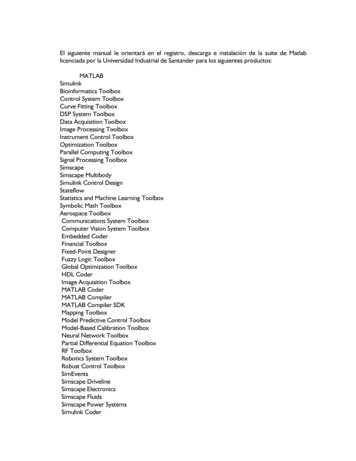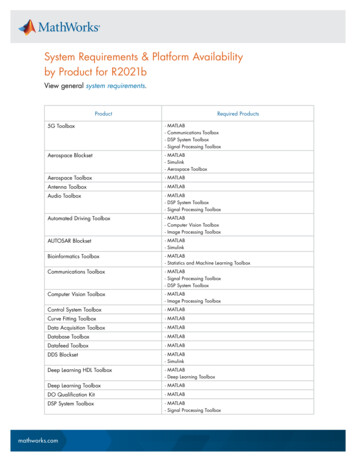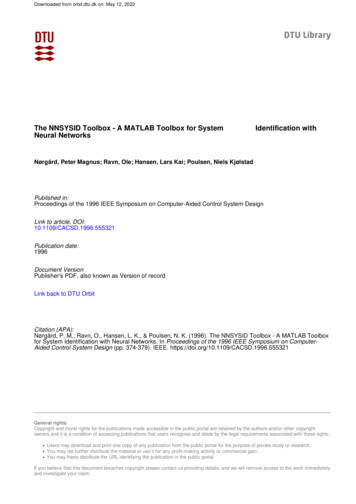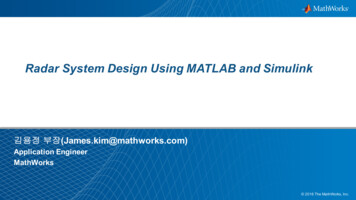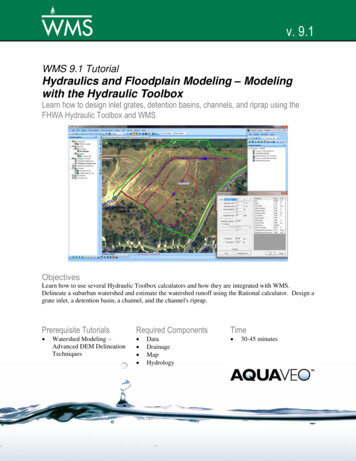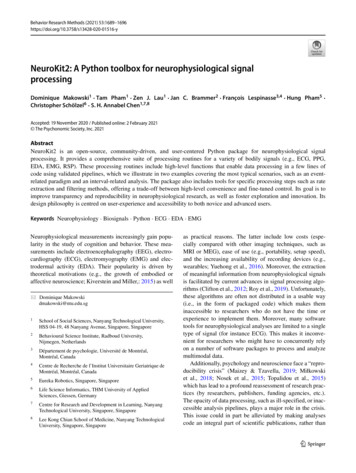
Transcription
Behavior Research Methods (2021) 1516-yNeuroKit2: A Python toolbox for neurophysiological signalprocessingDominique Makowski1 · Tam Pham1 · Zen J. Lau1 · Jan C. Brammer2 · François Lespinasse3,4 · Hung Pham5 ·Christopher Schölzel6 · S. H. Annabel Chen1,7,8Accepted: 19 November 2020 / Published online: 2 February 2021 The Psychonomic Society, Inc. 2021AbstractNeuroKit2 is an open-source, community-driven, and user-centered Python package for neurophysiological signalprocessing. It provides a comprehensive suite of processing routines for a variety of bodily signals (e.g., ECG, PPG,EDA, EMG, RSP). These processing routines include high-level functions that enable data processing in a few lines ofcode using validated pipelines, which we illustrate in two examples covering the most typical scenarios, such as an eventrelated paradigm and an interval-related analysis. The package also includes tools for specific processing steps such as rateextraction and filtering methods, offering a trade-off between high-level convenience and fine-tuned control. Its goal is toimprove transparency and reproducibility in neurophysiological research, as well as foster exploration and innovation. Itsdesign philosophy is centred on user-experience and accessibility to both novice and advanced users.Keywords Neurophysiology · Biosignals · Python · ECG · EDA · EMGNeurophysiological measurements increasingly gain popularity in the study of cognition and behavior. These measurements include electroencephalography (EEG), electrocardiography (ECG), electromyography (EMG) and electrodermal activity (EDA). Their popularity is driven bytheoretical motivations (e.g., the growth of embodied oraffective neuroscience; Kiverstein and Miller,: 2015) as well Dominique Makowskidmakowski@ntu.edu.sg1School of Social Sciences, Nanyang Technological University,HSS 04-19, 48 Nanyang Avenue, Singapore, Singapore2Behavioural Science Institute, Radboud University,Nijmegen, Netherlands3Département de psychologie, Université de Montréal,Montréal, Canada4Centre de Recherche de l’Institut Universitaire Geriatrique deMontréal, Montréal, Canada5Eureka Robotics, Singapore, Singapore6Life Science Informatics, THM University of AppliedSciences, Giessen, Germany7Centre for Research and Development in Learning, NanyangTechnological University, Singapore, Singapore8Lee Kong Chian School of Medicine, Nanyang TechnologicalUniversity, Singapore, Singaporeas practical reasons. The latter include low costs (especially compared with other imaging techniques, such asMRI or MEG), ease of use (e.g., portability, setup speed),and the increasing availability of recording devices (e.g.,wearables; Yuehong et al., 2016). Moreover, the extractionof meaningful information from neurophysiological signalsis facilitated by current advances in signal processing algorithms (Clifton et al., 2012; Roy et al., 2019). Unfortunately,these algorithms are often not distributed in a usable way(i.e., in the form of packaged code) which makes theminaccessible to researchers who do not have the time orexperience to implement them. Moreover, many softwaretools for neurophysiological analyses are limited to a singletype of signal (for instance ECG). This makes it inconvenient for researchers who might have to concurrently relyon a number of software packages to process and analyzemultimodal data.Additionally, psychology and neuroscience face a “reproducibility crisis” (Maizey & Tzavella, 2019; Miłkowskiet al., 2018; Nosek et al., 2015; Topalidou et al., 2015)which has lead to a profound reassessment of research practices (by researchers, publishers, funding agencies, etc.).The opacity of data processing, such as ill-specified, or inaccessible analysis pipelines, plays a major role in the crisis.This issue could in part be alleviated by making analysescode an integral part of scientific publications, rather than
1690treating a paper as the sole and most important part of theresearch project. However, distributing the analysis scriptalongside the paper poses new challenges: Scripts must beshareable (not always feasible with closed-source and proprietary software or programming languages), accessible(well-documented and organized scripts) and reproducible(which is difficult for software relying on graphical userinterfaces - GUI - in which the manual point-and-clicksequence can be hard to automate).NeuroKit2, addresses these challenges by offering a free,user-centered, and comprehensive solution for neurophysiological data processing, with an initial focus on bodily signals including ECG (electrocardiography is used to measurecardiac activity), PPG (photoplethysmogram is an opticalmeasurement of blood flow), RSP (respiration measures),EDA (electrodermal activity measuring the electrical conductance of the skin), EMG (electromyography measuringmuscular activity) and EOG (electrooculography measuring eye movements). It also provides modality-independentfunctions that can be used for other modalities such as EEG(electroencephalography measuring electrical activity of thebrain), for which more specific support is in development.The open-source Python package is developed by amulti-disciplinary team that actively invites new collaborators. The target audience of NeuroKit2 includes bothexperienced and novice programmers. Although being aprogramming-based tool, users not familiar with Python orother languages can start using the software (and improvetheir programming skills along the way) by following ourstep-by-step examples. Moreover, we also include a thorough tutorial on Python installation, as well as a “10 minutesintroduction to Python” in the documentation. While manyof the existing software caters to a single signal modality (e.g., KUBIOS (Tarvainen et al., 2014), HeartPy (vanGent et al., 2019) and pyHRV (Gomes et al., 2019) forECG, cvxEDA (Greco et al., 2015), Ledalab (Benedek &Kaernbach, 2010), and SCRalyze (Bach, 2014) for EDA),NeuroKit2 provides support for various signals and allowsits users to process signals from multiple physiologicalmodalities with a uniform application programming interface (API). It aims at being accessible, well-documented,well-tested, cutting-edge, flexible and efficient. The libraryallows users to select from a wide range of validated analysis pipelines and to create custom pipelines tailored tospecific analyses requirements. Historically, NeuroKit2 isthe re-forged successor of NeuroKit “1” (Makowski, 2020),taking over its most successful features and design choices,and re-implementing them in a way that adheres to currentbest practices in open source software development.NeuroKit2 offers a breadth of functionalities whichincludes, but is not limited to, signal simulation; datamanagement (e.g., downloading existing datasets, readingand formatting files into a dataframe); event extraction fromBehav Res (2021) 53:1689–1696signals; epoch extraction, signal processing (e.g., filtering,resampling, rate computation using different publishedalgorithms detailed in the package’s documentation);spectral analyses; complexity and entropy analyses; andconvenient statistical methods (e.g., K-means clustering,ICA or PCA). A variety of plotting functions allow for quickand expressive visualization of the signal processing and theresulting features.The package is implemented in Python 3 (Van Rossum& Drake, 2009), which means that NeuroKit2’s usersbenefit from an large number of learning resources anda vibrant community. The package depends on relativelyfew, well established and robust packages from the numericPython ecosystem such as NumPy (Harris et al., 2020),pandas (McKinney & et al. 2010), SciPy (Virtanen et al.,2020), scikit-learn (Pedregosa et al., 2011) and MatplotLib(Hunter, 2007) (with an additional system of optionaldependencies), making NeuroKit2 a viable dependency forother packages.NeuroKit2’s source code is available under the MIT licenseon GitHub ocumentation(https://neurokit2.readthedocs.io/)is automatically built and rendered from the code andincludes guides for installation and contribution, adescription of the package’s functions, as well as several“hands-on” examples and tutorials (e.g., how to extractand visualize individual heartbeats, how to analyze eventrelated data etc.). Importantly, users can add new examplesby simply submitting a Jupyter notebook (Kluyver et al.,2016) to the GitHub repository. The notebook will automatically be displayed on the website, ensuring easilyaccessible and evolving documentation. Moreover, userscan try out the example notebooks directly in their browservia a cloud-based Binder environment (Jupyter et al.,2018). Finally, the issue tracker on GitHub offers a convenient and public forum that allows users to report bugs,get help and gain insight into the development of thepackage. Our active collaborators range from academics,professionals and practitioners in the life sciences andengineering fields (See the “authors” section on the package’s documentation). Based on community feedbackthat we received (social networks, GitHub issues), NeuroKit2 has attracted users of different profiles, ranging fromthose who are new to signal processing and programmingto more experienced users.NeuroKit2 aims at being reliable and trustworthy,including implementations of processing pipelines that havebeen described in peer-reviewed publications. Details andreferences regarding those pipelines are available in thepackage’s documentation. Many pipelines have been testedagainst established software such as BioSPPy (Carreiraset al., 2015), hrv (Bartels & Pecanha, 2020), PySiology(Gabrieli et al., 2019), HeartPy (van Gent et al., 2019),
Behav Res (2021) 53:1689–1696systole (Legrand & Allen, 2020) or nolds (Schölzel, 2019).Additionally, the repository leverages a comprehensivetest suite (using pytest) and continuous integration (usingTravis-CI and GitHub actions) to ensure software stabilityand quality. The test coverage and build status cantransparently be tracked via the GitHub repository. Thanksto its collaborative and open development, NeuroKit2 canremain cutting-edge and continuously evolve, adapt, andintegrate new methods as they are emerging.Finally, we believe that the design philosophy ofNeuroKit2 contributes to an efficient (i.e., allowing toachieve a lot with few functions) yet flexible (i.e., enablingfine control and precision over what is done) UI. We willillustrate these claims with two examples of common usecases (the interval-related analysis on resting state data andthe event-related analysis), and will conclude by discussinghow NeuroKit2 contributes to neurophysiological researchby raising the standards for validity, reproducibility andaccessibility.Design philosophyNeuroKit2 aims at being accessible to beginners and, atthe same time, offering a maximal level of control toexperienced users. This is achieved by allowing beginningusers to implement complex processing pipelines witha few functions, while still providing experienced userswith fine-tuned control over arguments and parameters. Inconcrete terms, this trade-off is enabled by an API structureorganized in three layers.Low-level: Base utilities for signal processingThe basic building blocks are functions for general signal processing, i.e., filtering, resampling, interpolation, peak detection, etc. These functions are modality-independent, andinclude several parameters (e.g., one can change the filteringmethod, frequencies, and order, by overwriting the defaultarguments). Most of these functions are based on establishedalgorithms implemented in scipy (Virtanen et al., 2020).Examples of such functions include signal filter(),signal resample(),signal interpolate(),signal detrend(), and signal findpeaks().Mid-level: Neurophysiological processing stepsThe base utilities are used by mid-level functions specific tothe different physiological modalities (i.e., ECG, RSP, EDA,EMG, PPG). These functions carry out modality-specificsignal processing steps, such as cleaning, peak detection,1691phase classification or rate computation. Critically, foreach type of signal, uniform function names are used (inthe form signaltype functiongoal()) to achieveequivalent goals, e.g., * clean(), * findpeaks(),* process(), * plot(), making the implementationintuitive and consistent across different modalities.For example, the rsp clean() function usessignal filter() and signal detrend(), withdifferent sets of default parameters that can be switchedwith a “method” argument (corresponding to differentpublished or established pipelines). For instance, settingmethod "khodadad2018" will use the cleaning workflow described in Khodadad et al. (2018). However, if auser wants to build their own custom cleaning pipeline,they can use the cleaning function as a template, andtweak the parameters to their desires in the low-level signalprocessing operations.High-level wrappers for processing and analysisThe mid-level functions are assembled in high-levelwrappers, that are convenient entry points for newusers. For instance, the ecg process() function internally chains the mid-level functions ecg clean(),ecg peaks(), ecg quality(), ecg delineate(),and ecg phase(), as shown in Fig. 1. A specific processing pipeline can be selected with the method argumentthat is then propagated throughout the internal functions.Easily switching between processing pipelines allows forthe comparison of different methods, and streamlines critical but time-consuming steps in reproducible research,such as the validation of data preparation and quality control (Quintana et al., 2016). Finally, the packageincludes convenience-functions (e.g., bio process) thatenable the combined processing of multiple types of signals at once (e.g., bio process(ecg ecg signal,eda eda signal)).Performing an entire set of operations with sensibledefault parameters in one function can be rewarding, especially for beginners, allowing them to perform cutting-edgeprocessing or replication of research steps without requiring much programming expertise. Moreover, it contributesto the demystification of the usage of programming tools(as opposed to GUI-based software such as SPSS, Kubios,or Acqknowledge), providing a welcoming framework tofurther explore physiological data processing. Importantly,more advanced users can build custom analysis pipelinesby using the low- and mid-level functions, allowing forfiner control over the processing parameters. We believe thatthis implementation is a well-calibrated trade-off betweenflexibility and user-friendliness.
1692Behav Res (2021) 53:1689–1696Fig. 1 Illustration of the NeuroKit2 package architecture, in the case of ECG signal processingInstalling NeuroKit2NeuroKit2 is available on PyPI, a repository of softwarefor the Python programming language. and can be installedusing pip (via “pip install neurokit2” command). Detailedinstructions on how to install Python are also available inthe installation section of the package’s documentation.ExamplesIn this section, we present two examples that illustratethe most common use-cases (Fig. 2). Both examples canbe accessed in an interactive format (without any priorinstallation) via a Binder environment. The first exampleillustrates an interval-related paradigm where characteristicsof physiological activity during a certain time interval(not necessarily tied to a specific and sudden event)are extracted. The second example presents an eventrelated paradigm, in which the interest lies in shorter-termphysiological changes related to specific events (see Fig. 1and Table 1). The example datasets are available withthe package and can be downloaded using the data()function. This utility reads comma separated values files(.csv) with the Pandas function pd.read csv(), where eachcolumn is a different biosignal. Each row is a sample thatcorrespond to signals’ value at a given point in time. Allexamples use the 0.0.41 version release of NeuroKit2.Interval-related paradigmThe first dataset corresponds to 5 minutes of physiologicalactivity of a human participant at rest (eyes-closed in aseated position), with no specific instructions. It containsTable 1 Examples of features computed in different domainsInterval-related FeaturesEvent-related FeaturesECG Rate Characteristics (Mean, Amplitude)Heart Rate Variability (HRV) indicesRespiratory Rate Variability (RRV) indicesRespiratory Sinus Arrhythmia (RSA) indicesNumber of SCR Peaks and mean amplitudeECG Rate Changes (Min, Mean, Max, Time of Min, Max, Trend)RSP Rate Changes (Min, Mean, Max, Time of Min, Max)RSP Amplitude Measures (Min, Mean, Max)ECG and RSP Phase (Inspiration/Expiration, Systole/Diastole, Completion)SCR peak and its characteristics (amplitude, rise time, recovery time)
Behav Res (2021) 53:1689–16961693three channels (ECG, PPG and RSP) sampled at a frequencyof 100Hz.Here, the aim was to illustrate a type of physiologicalanalysis that we refer to as interval-related (or restingstate paradigm, as opposed to an event-related paradigm).After loading the package and the example dataset, eachphysiological signal is processed using bio process().As we want to compute features related to the entire dataset(see Table 2), we can directly pass the whole dataframeto bio analyze(), and compute the interval-relatedfeatures. Users can choose a specific time interval from theirdataset.Interval-related analyses compute features of signalvariability and activation patterns over a given period oftime, including average heart and breathing rate, as well asindices of heart rate variability (HRV) and respiratory sinusarrhythmia (RSA). NeuroKit2 allows for the fast creationof standardized and reproducible pipelines to describe thiskind of physiological activity.Event-related ParadigmThis example dataset contains ECG, RSP and EDA signalsof one participant who was presented with four emotionalimages (from the NAPS database; Marchewka et al., 2014)in a typical (albeit shortened) experimental psychologyparadigm.The signals are 2.5 minutes (150 seconds) long and arerecorded at a frequency of 100Hz (note that the samplingrate is lower than usually required, see Quintana et al.(2016), in order to be able to include the example datain the NeuroKit2 distribution). It has 4 channels includingthree physiological signals, and one corresponding to eventsmarked with a photosensor (signal strength decreases whena stimulus appears on the screen).In this example, the steps of the analysis are identicalto the previous example, including loading the package,the dataset and processing the data. The difference isthat stimulus onsets in the photosensor are detectedseparately with events find(). Once we have thepreprocessed signals and the location of events, we useepochs create() to slice the data into segmentscorresponding to a time window (ranging from -0.1 to 4seconds) around each stimulus. Finally, relevant features arecomputed for each epoch (i.e., each stimulus) by passingthem to bio analyze().Table 2 Subset of properties characterizing the physiological activity over a period of 5 minutes of resting-stateECG Rate MeanHRV RMSSDRSP Rate MeanRSA P2T Mean86.3938.8415.740.07
1694Behav Res (2021) 53:1689–1696Table 3 Subset of the ouput related to event-related analysis characterizing the pattern of physiological changes related to specific stimuliConditionECG Rate MeanRSP Rate MeanEDA Peak AmplitudeNegativeNeutralNeutralNegative 2.01 3.131.34 3.55 0.151.40 0.341.970.930.410.021.06Notably, the features include the changes in rate ofECG and RSP signals (e.g. maximum, minimum and meanrate after stimulus onset, and the time at which theyoccur), and the peak characteristics of the EDA signal (e.g.,occurrence of skin conductance response (SCR), and ifSCR is present, its corresponding peak amplitude, time ofpeak, rise and recovery time). In addition, respiration andcardiac cycle phases are extracted (i.e., the respiration phase- inspiration/expiration - and cardiac phase - systole/diastole- occurring at the onset of event).We hope that these examples demonstrate how straightforward the process of extracting features of physiologicalresponses can be with NeuroKit2. This pipeline can easilyscale up to group-level analyses by aggregating the averageof features across participants. In addition to streamlining data analyses, NeuroKit2 aims to allow researchers toextract an extensive suite of features that can be linked toneurocognitive processes. In this example (see Table 3),exposure to negative stimuli, as compared to neutral stimuli,is related to stronger cardiac deceleration, higher skin conductance response, and accelerated breathing rate (note thatthis descriptive interpretation is given solely for illustrativepurposes).Fig. 2 Plot window displaying a period of raw electrocardiogram(ECG in red), respiration (RSP in blue) and electrodermal activity(EDA in purple) data. The green highlighted section, spanning from 0to 20s, represents the periodic region of interest during interval-relatedanalysis. The 3 event markers are indicated by dotted lines, and theorange highlighted sections spanning 0.1s before the onset of eachevent and ending 4s after the event, represent periodic regions of interest during event-related analysis. The link for generating the figurecan be found on NeuroKit2’s GitHub repository master/paper/make figures.Rmd)DiscussionNeuroKit2 is a neurophysiological signal processing libraryaccessible to people across different levels of programmingexperience and backgrounds. For users who are noviceprogrammers or are new to neurophysiology, the packagepresents an ideal opportunity for exploration and learning.The experienced programmer is encouraged to chooseand validate the preprocessing and analysis pipelines mostappropriate for their data. Suggestions for improvements oradditions to the library are welcome and openly discussedin the community. Overall, the development of NeuroKit2is focused on creating an intuitive user-experience, as well
Behav Res (2021) 53:1689–1696as building a collaborative community. Its modular structureand organization not only facilitate the use of existingand validated processing pipelines, but also create a fertileground for experimentation and innovation.The library is also a pragmatic answer to thebroader need for transparent and reproducible methods inneurophysiology. The impact of our package on reproducibility in research is two-fold: firstly, while black-boxsoftware can be easy and convenient to use, users do nothave access to the source code, making processing resultssubject to unknown idiosyncrasies of the underlying implementation of processing routines. This makes it difficultto identify the source of potential discrepancies in resultsobtained with other software and can lead to irreproduciblefindings. In contrast, NeuroKit2 documents each step of theimplementation along with the analysis method, allowingusers to pin-point the analysis steps where differences mightarise. While maintaining a focus on overall user-experience,the open-source nature of NeuroKit2 encourages independent researchers to cross-validate research findings. Secondly, not only does NeuroKit2 implement several methodsfor analysis, it also allows for the comparison of different algorithms. For instance, using a suite of open-sourcedatabases, different algorithms for ECG R-peak detectionhave been compared for their robustness (number of errorsencountered), efficiency (computation time) and accuracy(absolute distance from true R-peak location), documentedin the “Studies” section of the package’s documentation. AsNeuroKit2 continues to work on benchmarking, we hope tosupport users in making more informed decisions regardingwhich method is most suited for their specific requirements.NeuroKit2 also prioritizes a high standard of qualitycontrol during code development. This is done throughautomated testing using continuous integration, as well asstriving for code simplicity and readability. The API isthoroughly documented, including working examples. Weensure that the documentation evolves alongside the code byincluding it in our continuous integration. While NeuroKit2currently has a fairly comprehensive documentation, moreexamples and tutorials will be added as the package growsand expands. Additionally, we provide thorough guidelinesfor new contributors who wish to contribute code ordocumentation.We expect the package’s future evolution to be drivenby the communities’ needs and the advances in relatedfields. For instance, although NeuroKit2 already implementsa lot of useful functions for EEG processing (such asentropy and fractal dimensions quantification), its supportcould be further improved (for example with high-levelfunctions built on top of utilities provided by the leadingEEG Python software, namely MNE, Gramfort et al.(2013). Additionally, in the future we strive to supportother types of bodily signals (e.g., electrogastrography -1695EGG, electrooculography - EOG) and plan to optimizecomputational efficiency on large datasets. We also planto further validate the available processing pipelines usingpublic databases. In line with this objective, the support ofstandardized data structure formats (e.g. WFDB, BIDS, . . . )could be extended.In conclusion, we believe that NeuroKit2 provides usefultools for anyone who is interested in analyzing physiological data collected with research-grade hardware or wearable“smart health devices”. By increasing the autonomy ofresearchers and practitioners, and by shortening the delaybetween data collection and results acquisition, NeuroKit2could be useful beyond academic research in neuroscienceand psychology, including applications such as personalphysiological monitoring and exercise science. Finally, wehope that NeuroKit2 encourages users to become part of asupportive open-science community with diverse areas ofexpertise rather than relying on closed-source and proprietary software, thus shaping the future of neurophysiologyand its related fields.Acknowledgments We would like to thank Prof. C. F. Xavier forinspiration, all the current and future contributors s.html), and the users for their support.Additionally, François Lespinasse would like to thank the CourtoisFoundation for its support through the Courtois-NeuroMod project(https://cneuromod.ca)Compliance with Ethical StandardsConflict of interests The authors declare that the research wasconducted in the absence of commercial or financial relationships thatcould constitute a conflict of interest.ReferencesBach, D. R. (2014). A head-to-head comparison of scralyze andledalab, two model-based methods for skin conductance analysis.Biological Psychology, 103, 63–68.Bartels, R., & Pecanha, T. (2020). HRV: A pythonic package for heartrate variability analysis. Journal of Open Source Software, 5(51),1867. https://doi.org/10.21105/joss.01867Benedek, M., & Kaernbach, C. (2010). A continuous measure ofphasic electrodermal activity. Journal of Neuroscience Methods,190(1), 80–91.Carreiras, C., Alves, A. P., Lourenço, A., Canento, F., Silva, H., Fred,A., & et al (2015). BioSPPy: Biosignal processing in Python.Retrieved from https://github.com/PIA-Group/BioSPPy/Clifton, D. A., Gibbons, J., Davies, J., & Tarassenko, L. (2012).Machine learning and software engineering in health informatics.2012 first international workshop on realizing ai synergies insoftware engineering (raise) (pp 37–41). IEEE.Gabrieli, G., Azhari, A., & Esposito, G. (2019). PySiology: Apython package for physiological feature extraction. In Neuralapproaches to dynamics of signal exchanges (pp. 395–402).Springer Singapore. https://doi.org/10.1007/978-981-13-8950-435Gomes, P., Margaritoff, P., & Silva, H. (2019). pyHRV: Developmentand evaluation of an open-source python toolbox for heart rate
1696variability (hrv). Proc. Int’l conf On electrical, electronic andcomputing engineering (icetran), 822–828.Gramfort, A., Luessi, M., Larson, E., Engemann, D. A., Strohmeier,D., Brodbeck, C., & et al. (2013). MEG and eeg data analysis withmne-python. Frontiers in Neuroscience, 7, 267.Greco, A., Valenza, G., Lanata, A., Scilingo, E. P., & Citi, L. (2015).CvxEDA: A convex optimization approach to electrodermal activity processing. IEEE Transactions on Biomedical Engineering,63(4), 797–804.Harris, C. R., Millman, K. J., Van der Walt, S. J., Gommers, R.,Virtanen, P., Cournapeau, D., & et al. (2020). Array programmingwith numpy. Nature, 585(7825), 357–362.Hunter, J. D. (2007). Matplotlib: a 2D graphics environment.Computing in Science & Engineering, 9(3), 90–95.Jupyter, B., Forde, F., Granger, H. W., Akici, F., Lippa, D., Niederhut,D., & Pacer, M. (2018). Binder 2.0 - Reproducible, interactive,sharable environments for science at scale. In Proceedings of the17th Python in Science Conference. , (pp. 113–120).Khodadad, D., Nordebo, S., Mueller, B., Waldmann, A., Yerworth, R.,Becher, T., & et al. (2018). Optimized breath detection algorithmin electrical impedance tomography. Physiological Measurement,39(9), 094001.Kiverstein, J., & Miller, M. (2015). The embodied brain: Towardsa radical embodied cognitive neuroscience. Frontiers in HumanNeuroscience, 9, 237.Kluyver, T., Ragan-Kelley, B., Pérez, F., Granger, B. E., Bussonnier,M., Frederic, J., & et al. (2016). Jupyter notebooks-a publishingformat for reproducible computational workflows. ELPUB, 87–90.Legrand, N., & Allen, M. (2020). Systole: A python toolbox for preprocessing, analyzing, and synchronizing cardiac data. Retrievedfrom oleMaizey, L., & Tzavella, L. (2019). Barriers and solutions for earlycareer researchers in tackling the reproducibility crisis in cognitiveneuroscience
NeuroKit2 is an open-source, community-driven, and user-centered Python package for neurophysiological signal processing. It provides a comprehensive suite of processing routines for a variety of bodily signals (e.g., ECG, PPG, EDA, EMG, RSP). These processing routines include high-level functions that enable data processing in a few lines of
